
The high-end 1911 handgun continues to be popular, so popular, in fact, that folks are willing to drop well over one thousand dollars to gain what they hope is superior performance. On a high-end pistol, “performance” often means features, such as good sights, forward cocking serrations, a good trigger compression, and attention to detail. The discerning shooter is looking for reliability first, then handling, accuracy, and fit and feel, and four handguns that are reputed to have those qualities at various price tags come from Colt and Springfield Armory. We recently tested two sidearms chambered in 45 ACP from each company that would interest nearly any buyer who was in the market for a self-defense arm. The products were Springfield’s Loaded Model PX9109LP, $790; and for hundreds more, the company’s Tactical Response Pistol, the TRP PC9108LP 45 ACP, $1347. To fit in that sizable price gap in the Springfield lineup, we selected Colt’s Combat Elite 08011XSE, $1015, and the Rail Gun XSE 01070RG, $1199. These are actual counter prices from BudsGunShop.com, and our intent was to survey a range of pricing to see if additional dollars translated into additional performance that would matter to our test team of shooters.
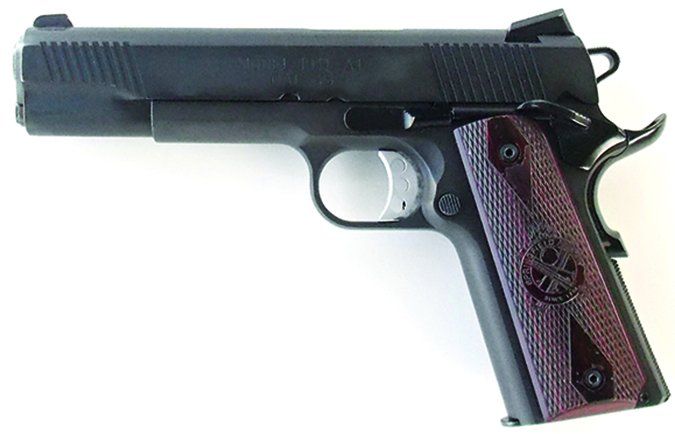
Among the most popular sidearms in terms of numbers sold are the Colt Combat Elite and the Springfield Loaded Model. A Colt Rail Gun variant is used by the U.S. Marine Corps, and the Springfield Bureau Model, similar to the TRP, by the FBI SWAT team. All four are combat guns intended to give the user an advantage in the field, so our thorough test involved a number of trained shooters who were asked to push the pistols to the limit, so we could discover the boundaries of control, combat accuracy, and absolute accuracy. We should also note that the Loaded Model was a rater’s personal carry gun. The rater stated it came out of the box running and has never given a complaint, and it has some 5,000 rounds through it. Cosmetically, it was hard to assess the status of the Loaded by just looking. The pistol is finished in a dull, non-reflective Parkerized finish that doesn’t show wear very much. The other pistols were new out of the box.
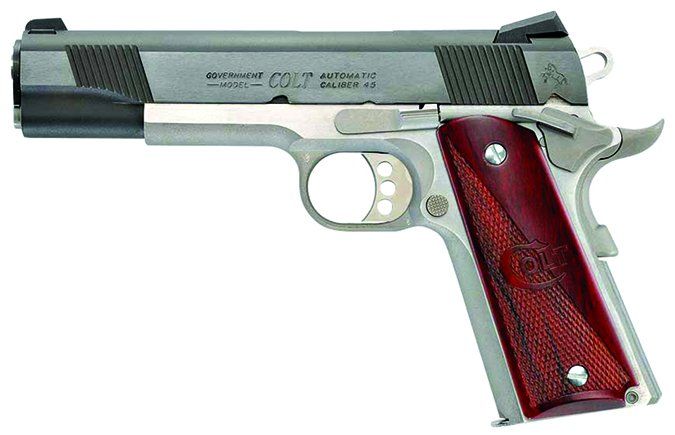
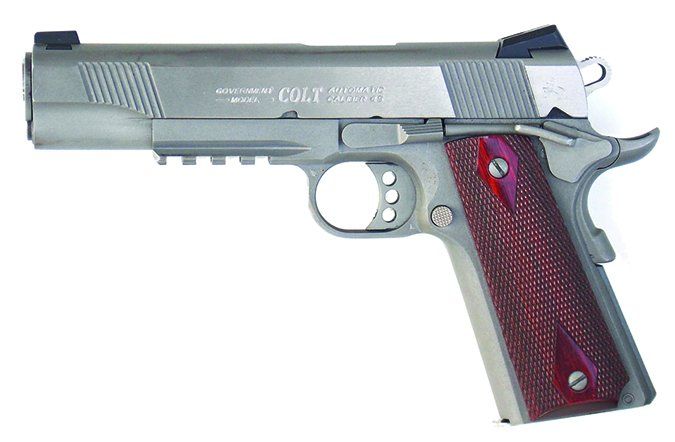
At this point we will mention the holsters used, as the Rail Gun demanded rail-specific holsters. The other three guns were easily passed around to the raters and standard holsters were used for them. For the Rail Gun, we had to invest in two holsters specific to it, with three raters doing most of the firing. We used Ted Blocker’s X 16 holster in both standard and 1911 rail-gun types. The holster was used both strong side and crossdraw, with excellent results. We also used a ZZZ Custom (ZZZCustomHolsters.com) Kydex strong-side holster, which gave a good fit on the Colt’s long bearing services and is relatively compact for a rail-gun holster. The other holster was a Sweetwater Saddlery strong-side pancake design that hugs the body.
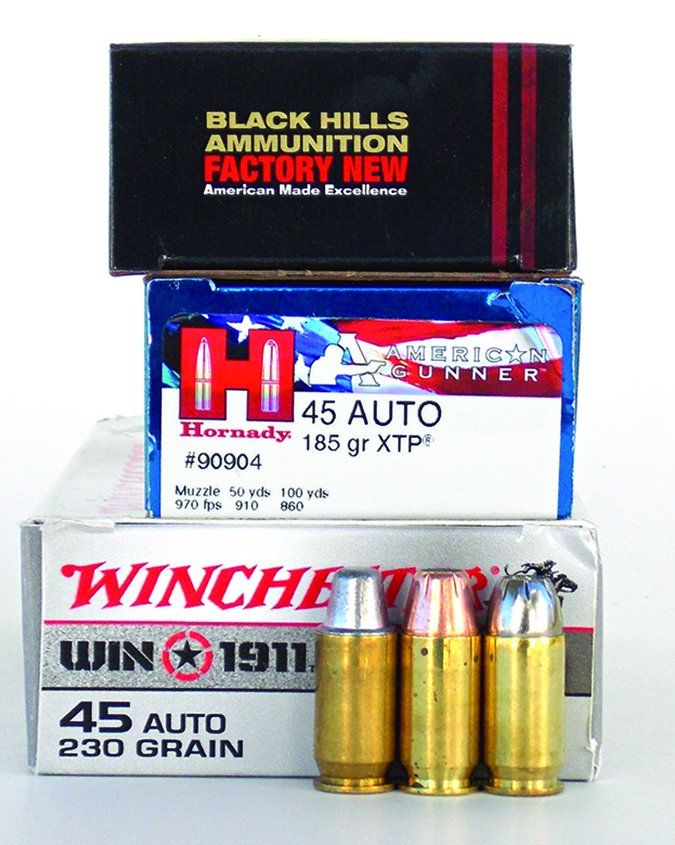
At the range, we used three loads. The Black Hills Ammunition 200-grain lead semi-wadcutter bullet was our training and practice load. Next, the Hornady American Gunner 185-grain XTP represented a lightweight-bullet defense load, and the Winchester M1911 230-grain jacketed hollowpoint stood in as a heavy defense load. These are affordable 45 ACP choices likely to be used by shooters. We expected that heavy bullets with a long bearing surface would demonstrate good accuracy, but in this case, the lightest bullet weight gave the best accuracy. Also, our shooters noted the heavier push of the 230-grain load. Following are objective data about each handgun, as well as the subjective opinions of our shooters based on head-to-head firing tests:
RANGE DATA
| BLACK HILLS AMMUNITION 200-grain SWC 45 ACP |
Springfield Armory Loaded | Springfield Armory TRP | Colt Rail Gun | Colt Combat Elite |
| Average Velocity | 870 fps | 890 fps | 888 fps | 866 fps |
| Muzzle Energy | 336 ft.-lbs. | 351 ft.-lbs. | 350 ft.-lbs. | 332 ft.-lbs. |
| Smallest Group | 2.2 in. | 1.5 in. | 1.9 in. | 1.6 in. |
| Largest Group | 2.6 in. | 2 in. | 2.5 in. | 2 in. |
| Average Group Size | 2.2 in. | 1.8 in. | 2.2 in. | 1.8 in. |
| HORNADY AMERICAN GUNNER 185-grain XTP 45 ACP |
Springfield Armory Loaded | Sprinfield Armory TRP | Colt Rail Gun | Colt Combat Elite |
| Average Velocity | 970 fps | 963 fps | 990 fps | 975 fps |
| Muzzle Energy | 386 ft.-lbs. | 380 ft.-lbs. | 402 ft.-lbs. | 390 ft.-lbs. |
| Smallest Group | 2 in. | 1.4 in. | 1.25 in. | 1.5 in. |
| Largest Group | 2.5 in. | 1.9 in. | 1.9 in. | 2.15 in. |
| Average Group Size | 2.5 in. | 1.5 in. | 1.9 in. | 2.3 in. |
| WINCHESTER M1911 230-grain JHP 45 ACP |
Springfield Armory Loaded | Springfield Armory TRP | Colt Rail Gun | Colt Combat Elite |
| Average Velocity | 871 fps | 860 fps | 866 fps | 888 fps |
| Muzzle Energy | 387 ft.-lbs. | 377 ft.-lbs. | 382 ft.-lbs. | 402 ft.-lbs. |
| Smallest Group | 2.3 in. | 1.3 in. | 1.8 in. | 2 in. |
| Largest Group | 2.7 in. | 1.6 in. | 2.1 in. | 2.5 in. |
| Average Group Size | 2.5 in. | 1.5 in. | 1.9 in. | 2.3 in. |
Average velocity readings were recorded by firing five-shot strings over a Competition Electronics Pro Chrono. Ambient temperature: 65 degrees. Elevation: 815 feet above sea level. Benchrest accuracy figures are the average of three five-shot groups at 25 yards. Ammunition sources: Black Hills Ammunition 200-grain Semi-Wadcutter D45N120 (www.MidwayUSA.com); Hornady American Gunner 185-grain XTP 90904 (SportsmansGuide.com); Winchester M1911 230-grain Jacketed Hollowpoint X45P (CheaperThanDirt.com).
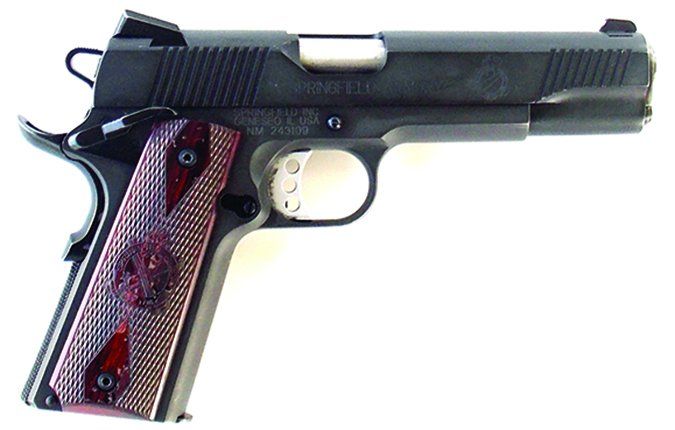
Springfield Loaded Model PX9109LP 45 ACP, $790
GUN TESTS GRADE: B (Best Buy)
Although we rated the Loaded Model down a notch on accuracy, this Springfield 45 is a good choice for home defense, carry, IDPA, and as an all-round go-anywhere do-anything handgun.
| ACTION | Single action, semi-auto, locked breech |
| OVERALL LENGTH | 8.6 in. |
| OVERALL HEIGHT | 5.4 in. |
| MAX WIDTH | 1.5 in. |
| WEIGHT UNLOADED | 39 oz. |
| WEIGHT LOADED | 43.5 oz. |
| BARREL | 5 in., Match grade; stainless steel, 1:16 twist |
| MAGAZINE | (2) 8-Rd. blued steel |
| SLIDE | Parkerized steel; 2-piece N.M. Full-length guide rod |
| FRAME | Parkerized steel |
| FRAME FRONT STRAP HEIGHT | 2.6 in. |
| FRAME BACK STRAP HEIGHT | 3.2 in. |
| GRIPS | Laser-engraved Cocobolo |
| GRIP THICKNESS (MAX) | 1.3 in. |
| GRIP CIRCUMFERENCE (MAX) | 5.4 in. |
| SIGHTS | Steel, fixed combat, 3-dot Tritium |
| TRIGGER PULL WEIGHT | 5 lbs. |
| TRIGGER SPAN | 2.5 in. |
| SAFETY | Ambi slide lock safety, grip safety |
| WARRANTY | Lifetime |
| TELEPHONE | (800) 680-6866 |
| SITE | Springfield-Armory.com |
| MADE IN | Geneseo, Illinois |
The Springfield Loaded Model occupies much the same position in its company’s lineup as the Colt Combat Elite. The Combat Elite is close to the Jeff Cooper description of having only what is needed — and nothing more — on a fighting handgun. The Loaded Model was a response to market pressure to offer a handgun with what originally were considered to be custom features over and above its G.I. Model and the Mil-Spec Model (the latter of which is still available from Springfield). We tested both of these lower-priced handguns in the May 2010 issue and graded the G.I. PW9108LP 45 ACP, $643, as a B+ handgun, and the similar but stainless G.I. PW9151LP 45 ACP, $693, as a C. The Mil-Spec PB9108LP Parkerized, $753, got an A grade.
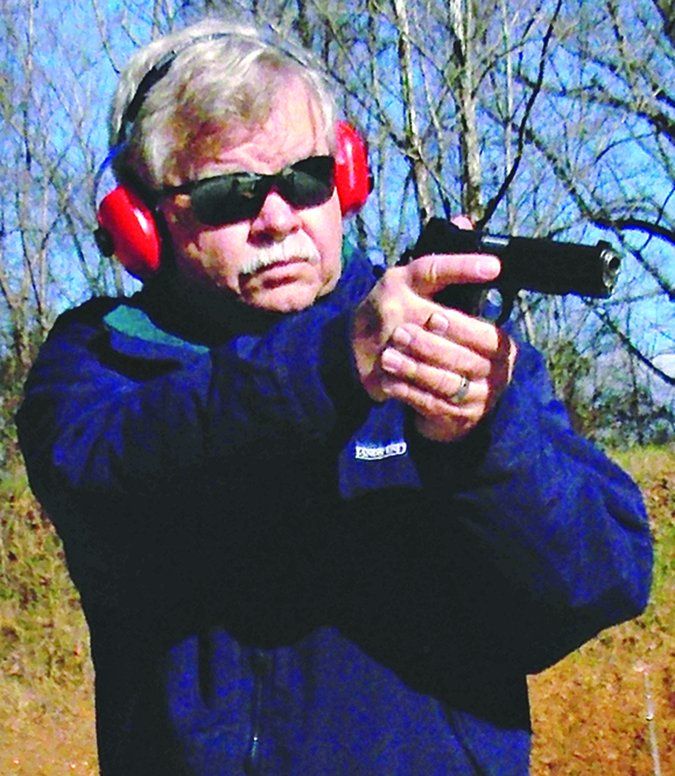
As a rule, the Loaded Model is more tightly fitted than the G.I. Models, in particular the barrel, barrel lugs, and barrel bushing. Thus, in benchrest-accuracy testing, the Loaded Model may be more accurate than the G.I. 1911A1 by a noticeable margin. It was clear during this test that the Loaded Model is not the chassis for the TRP, nor could the shooter easily modify the Loaded Model to TRP status. The frame and slide of the TRP are much more tightly fitted, we learned, which must be done during manufacturing. Or, by the time you pay a gunsmith to tighten the frame-to-slide fit, you could simply have purchased the TRP, minus barrel fitting and front-strap treatment.
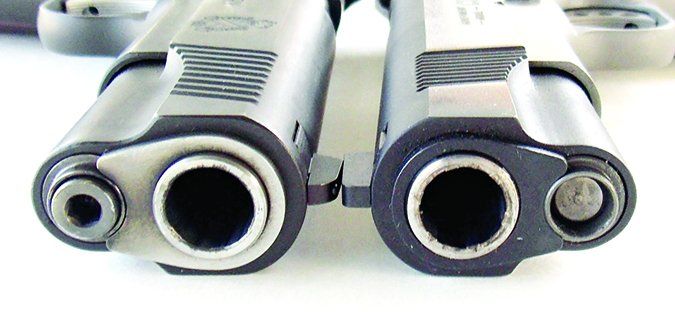
The Loaded Model featured Novak Lo Mount sights front and rear. So do the other three handguns, but only the TRP features night-sight inserts. The Loaded Model had forward cocking serrations like the others. We assessed the fit of the barrel to the slide with a stainless-steel barrel bushing to be tight enough for good accuracy potential. Its full-length guide rod may be disassembled with a large Allen wrench. A two-piece guide rod is the easier design to disassemble. Some believe a one-piece unit will work loose with extensive firing, but we did not experience this problem during our test shooting. If it were to be a problem, the simple fix would be to check the full-length guide rod for tightness and screw it tight every few hundred cartridges fired. But our experienced raters have not observed a properly tightened full-length guide rod working loose.
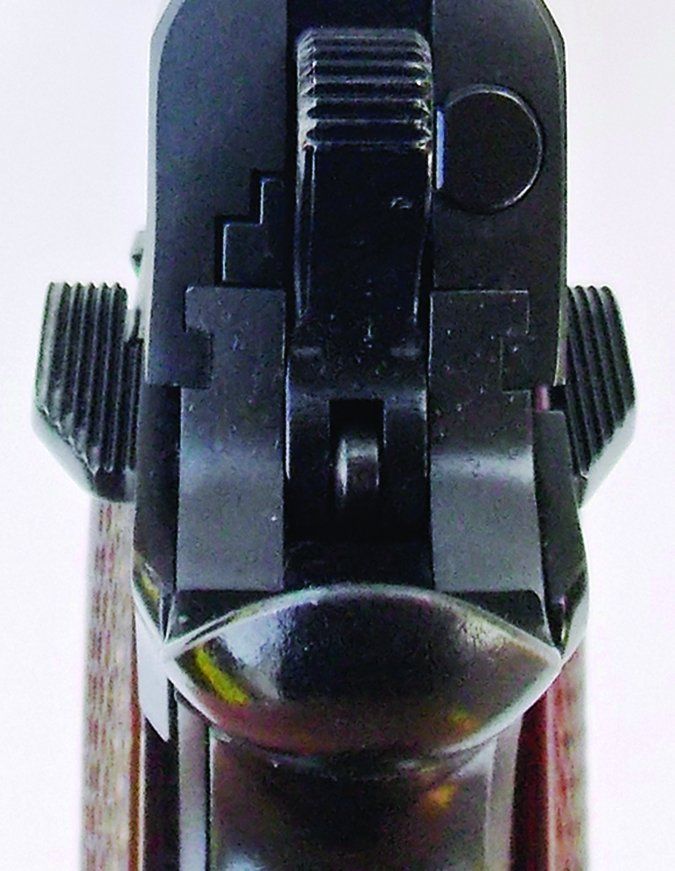
Trigger compression was consistent among four remarkably similar trigger actions. The Loaded Model broke at a clean 5 pounds. The initial testing was conducted by firing 150 rounds in each pistol in a series of combat drills. We drew from a strong-side holster and fired at man-sized silhouette targets at 7 and 10 yards. We also fired at the InnovativeTargets.net steel gong target at 25 yards. In addition to the commercial loads we used to ensure shooters across the country can validate our test results, we also used handloads to save money.
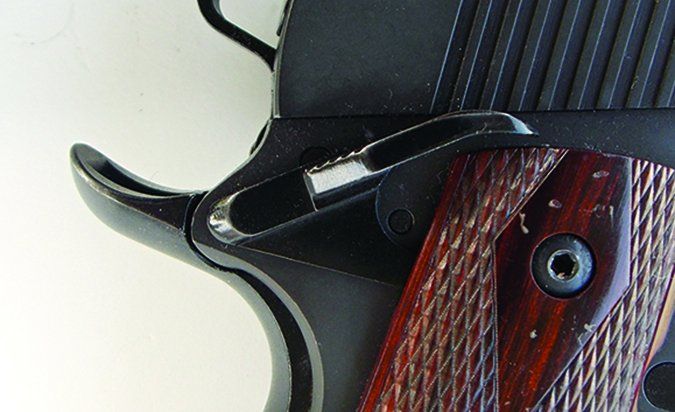
The first was a combination of the Montana Gold 185-grain JHP and enough WW231 for 950 FPS. We fired more than 100 of these in each handgun. To confirm accuracy with lead bullet reloads, essential for economical practice, we used the Magnus 200-grain semi-wadcutter bullet over enough Titegroup powder for 890 fps in the next 50 rounds. Both loads fed, chambered, fired, and ejected normally and showed good practical accuracy. The Loaded Model’s two supplied magazines were supplemented with 7-round Brownells’ magazines. The single best accuracy result we saw was a group with the American Gunner load, five rounds in 2 inches at 25 yards. This is fine accuracy for a service-grade pistol, but, overall, it was a notch less accurate than the other handguns.
Our Team Said: The Loaded Model was a combination with good features for the self-defense shooter, but we rated it down a grade because it wasn’t quite as accurate as the other pistols. The matte finish, while durable, was not as well turned out as the other handguns. But for the money, it’s hard to beat, so it gets our Best Buy designation.
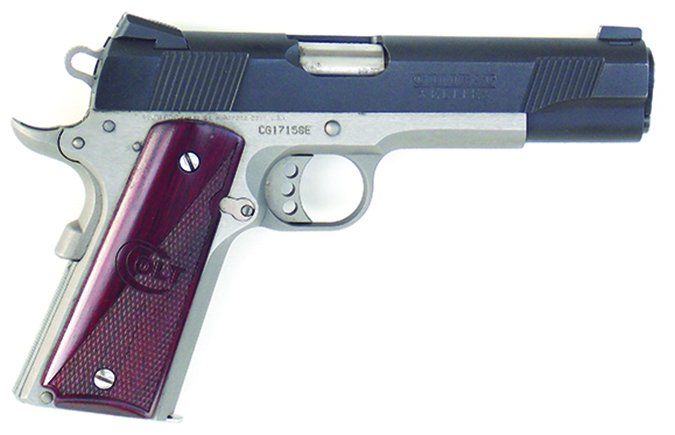
Colt Combat Elite 08011XSE 45 ACP, $1015
GUN TESTS GRADE: B
The Colt Combat Elite offered excellent trigger action, good accuracy, relatively light weight for a steel-frame 1911, and top-quality fit, finish, and appearance. Combat shooting accuracy was good, and speed from concealed carry excellent. We rated it down based on the lack of an ambidextrous safety.
| ACTION | Single-action, semi-auto, locked breech, series 80 |
| OVERALL LENGTH | 8.5 in. |
| OVERALL HEIGHT | 5.4 in. |
| MAX WIDTH | 1.5 in. |
| WEIGHT UNLOADED | 38 oz. |
| WEIGHT LOADED | 42.5 oz. |
| BARREL LENGTH | 5 in. |
| BARREL | Stainless steel, national match, 1:16 twist; full-length guide rod |
| MAGAZINE | 8-Rd. detachable box |
| SLIDE | Carbon steel, brushed blued finish, lowered & flared ejection port, front & rear serrations |
| FRAME | Brushed stainless steel |
| FRAME FRONT STRAP HEIGHT | 2.6 in. |
| FRAME BACK STRAP HEIGHT | 3.2 in. |
| GRIPS | Wood, half smooth, half checkered |
| GRIP THICKNESS (MAX) | 1.3 in. |
| GRIP CIRCUMFERENCE (MAX) | 5.4 in. |
| SIGHTS | Novak Lo Mount Carry |
| TRIGGER PULL WEIGHT SINGLE ACTION | 5 lbs. |
| TRIGGER SPAN SINGLE ACTION | 2.5 in. |
| SAFETY | Single side slide lock safety |
| WARRANTY | Limited lifetime |
| SITE | Colt.com |
| TELEPHONE | (800) 962-COLT (2658) |
| MADE IN | Hartford, CT |
| MADE BY | Colt’s Manufacturing, Co., LLC |
The Colt Combat Elite is a specialized version of Colt’s XSE guns and a stablemate to the Colt Rail Gun. The Combat Elite, like the others, is a 5-inch-barrel Government Model handgun with a steel frame. The Colt Combat Elite has the features of the Colt XSE series, including Novak sights, forward cocking serrations, a match trigger, and a beavertail grip safety. Even so, the Combat Elite is advertised as a “back to the basics” Colt, and we understand the appeal. As outfitted, the pistol was striking.
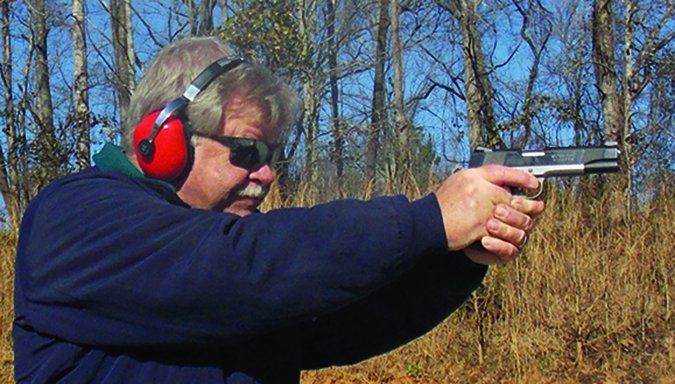
A feature of the XSE series is a concave gap beneath the trigger guard just at the top of the front strap. This concave area serves to lower the bore axis into the shooter’s hand. An advantage of the 1911 type is a low bore centerline, and this dished out portion helped even further. A properly designed beavertail grip safety also lowered the bore axis, resulting in less leverage for the muzzle to rise against in recoil. The Colt uses the Series 80 firing pin block or drop safety. The Springfield 1911 handguns use a lightweight firing pin and heavy-duty firing-pin spring as a drop safety. The lightweight firing pin design of the Springfield passed rigid FBI testing, so its field function shouldn’t be a worry for the self-defense shooter.
The Colt slide was nicely finished in blue. The frame was stainless steel. The slide featured forward and rear cocking serrations, Novak sights with white outline and a scalloped ejection port. Fit of the barrel hood, barrel bushing, and locking lugs gained our approval. The slide rolled smoothly on the link, showing excellent fitting. The barrel feed ramp featured the relatively new Colt dimple in the ramp that works well in feeding every bullet design we have tried. The beavertail grip safety was well designed and seemed identical to the Springfield. The pistol’s slide-lock safety was not ambidextrous. Because tactical training involves using the handgun with either hand — regardless of the shooter’s favored hand — this is a demerit among high-end 1911s. The Rail Gun cost a few dollars more but features both a rail and an ambidextrous safety.
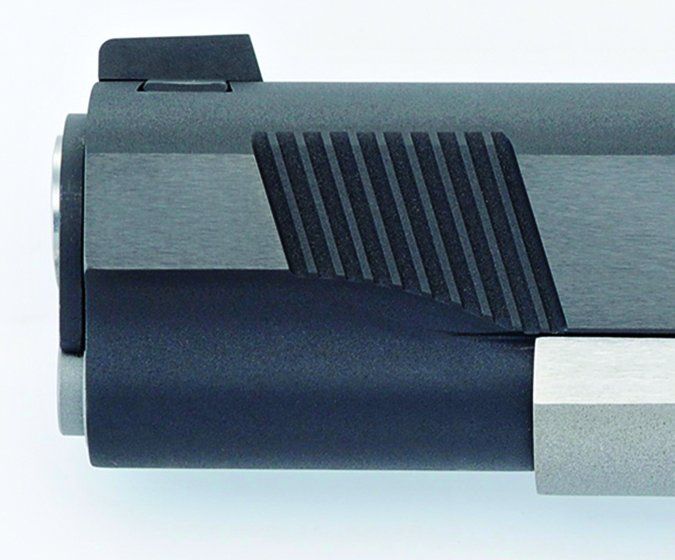
In character, this back-to-the-basics Colt features a full-length guide rod that’s one piece, which is less likely to work loose but which is more complicated to field strip. The grip safety properly releases its hold on the trigger about half way into compression. The mainspring housing is not heavily serrated, but offers some adhesion. The grips are attractive, half checkered and featuring the Colt logo. The purpose of the tactical grip is to afford the user good abrasion when firing but also to allow good hand adjustment, quickly, during movement. They work as designed, although we prefer the Ahrend’s Grips original tactical grip design. The front strap was not checkered, in contrast to the TRP, which featured a checkered front strap. The Colt had an advantage with a nice 5.0-pound trigger compression, exactly one half pound lighter than the TRP, and in our view, the Colt trigger was tighter with less take up. The Colt was supplied with two magazines.
The Colt was lubricated and the magazines loaded with ammunition for the initial testing with the allocated 150 rounds to each pistol. The Colt Combat Elite cleared leather quickly and proved accurate and controllable in combat-style shooting. There were no failures to feed, chamber, fire, or eject. The sights were properly regulated for 230-grain loads. While the Colt was tight, there were no break-in malfunctions. A combination of good sights and a great trigger gave good results on the silhouette targets. The pistol was not lubricated again during range work as the raters passed the pistol around and fired, loaded magazines, and finally picked up the brass. The Colt showed reliability and clearly was an effective personal-defense handgun. We thought it was a better shooter than the Loaded Model, but at something of a price premium.
Firing off the benchrest, the Colt’s smooth trigger compression gave good results. The pistol was slightly more accurate than the Rail Gun and more accurate than the Loaded Model as well. The single best group came with the Hornady American Gunner 185-grain XTP at 1.5 inches, although the average with this round was larger.
Our Team Said: This pistol was reliable, accurate, and handled well. We would carry the Colt for personal defense without hesitation. But the Springfield Loaded pistol has more features for the money, and the TRP is more accurate. Also, we rated the Combat Elite down based upon a lack of an ambidextrous safety that most pistols in this price range have. If the pistol was designed as a clean and classic Colt, so be it, it succeeds.
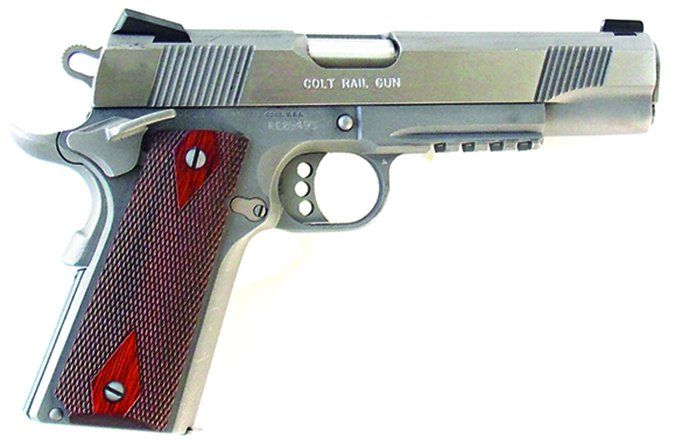
Colt Rail Gun 01070RG 45 ACP, $1199
GUN TESTS GRADE: A
The Colt Rail Gun is an all-stainless 1911 with impressive performance. Novak sights, an ambidextrous safety, a rail mount and excellent performance gave the pistol a lead over the Combat Elite with equal features and then some.
| ACTION | Single-action, semi-auto, locked breech, series 80 |
| OVERALL LENGTH | 8.5 in. |
| OVERALL HEIGHT | 5.4 in. |
| MAX WIDTH | 1.5 in. |
| WEIGHT UNLOADED | 39 oz. |
| WEIGHT LOADED | 43.5 oz. |
| BARREL | 5 in., national match stainless steel, 1:16 twist |
| MAGAZINE | 8-Rd. detachable box |
| SLIDE | Brushed stainless steel, lower & flared ejection port |
| FRAME | Brushed stainless steel, 1913 accessory rail |
| FRAME FRONT STRAP HEIGHT | 2.6 in. |
| FRAME BACK STRAP HEIGHT | 3.2 in. |
| GRIPS | Checkered double diamond |
| GRIP THICKNESS (MAX) | 1.3 in. |
| GRIP CIRCUMFERENCE (MAX) | 5.4 in. |
| SIGHTS | Novak Carry with dots |
| TRIGGER PULL WEIGHT SINGLE ACTION | 5.5 lbs. |
| TRIGGER SPAN SINGLE ACTION | 2.5 in. |
| SAFETY | Ambidextrous slide lock safety, grip safety |
| WARRANTY | Limited lifetime |
| SITE | Colt.com |
| TELEPHONE | (800) 962-COLT (2658) |
| MADE IN | Hartford, CT |
| MADE BY | Colt’s Manufacturing Co., LLC |
Colt’s Rail Gun appears at first as simply an XSE-series pistol with a rail. While this is true in basic terms, the pistol’s geometry is subtly altered, making it more muzzle heavy than the other handguns, and it seems to absorb recoil better, although it weighs little more than the other 1911s and is lighter than the TRP.
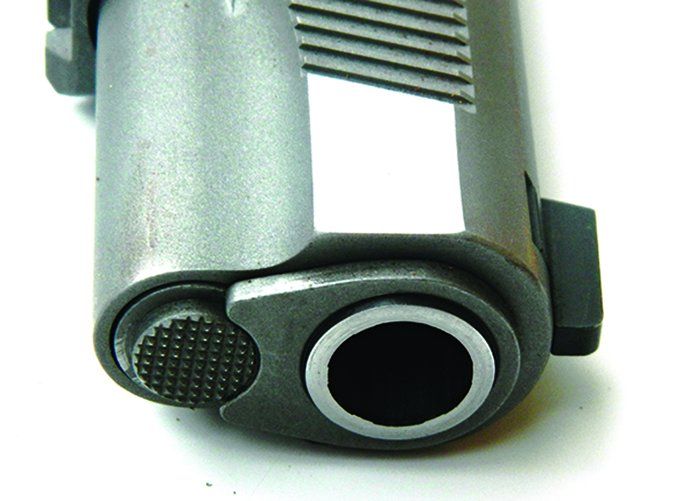
The Colt Rail Gun featured a stainless-steel frame and slide. The finish was well polished. The checkered cocobolo grips were double-diamond designs. These double diamonds offer a classic appearance and also reinforce the area that attaches to the grip frame. These grips were well made and worked well, but in the opinion of our testers, they do not offer the adhesion of the TRP’s G10 grips. The fit of the barrel to the slide and the bushing to the barrel were excellent. The fit wasn’t so tight the pistol cannot be field-stripped with the fingers. Just the same, we used a bushing tool. After disassembling 1911 handguns over the course of a few weeks and cleaning them before accuracy testing, a bushing wrench came in handy. The Colt Rail Gun does not use a full-length guide rod, but, rather, the original short guide rod. For fast cleaning and easy maintenance, this is the preferred set up. As one of the more experienced raters noted, for an issue handgun, the Rail Gun set up is superior. Separating it from the TRP’s set up, we think the latter is better suited for a well-trained smaller team or individual. As a consensus, we all agreed with this proposition.
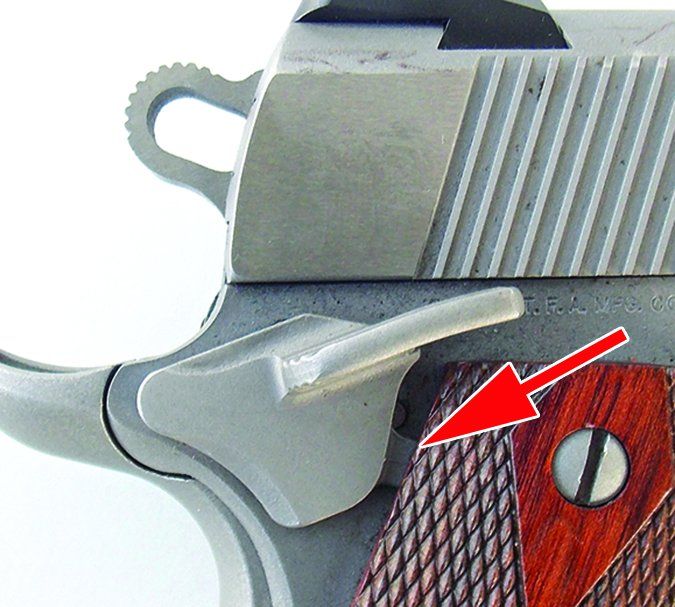
The slide-lock safety was an ambidextrous unit that allowed the use of the Colt by either hand, an upgrade over the Combat Elite, in our view. There were no problems with the Colt safety; however, we prefer the Swenson-based design of the Springfield. The Colt safety was supported by the right-hand grip panel, less obviously than on the Springfield. The Colt beavertail grip safety was well designed. Shooters who occasionally let the palm of the hand rise off the standard grip safety during firing will find that all of the beavertail safeties will work about the same for them. Our shooters noticed very little difference in where the safeties engaged in the sweep of the beavertail’s movement.
The Rail Gun trigger compression registered 5.5 pounds, with exactly the same weight and feel as the TRP. The pistol featured forward cocking serrations and a 16-pound recoil spring. The hammer of the TRP required less effort to cock. The sights share a common design with the other pistols, Novak Lo Mounts, with white-dot inserts. The primary difference between this gun, the Colt Combat Elite, and the Springfield Loaded Model is the rail. If you must have a rail, this is the gun to choose from among these four, but we note that Springfield also offers a TRP rail gun, the PC9105LCA. We do want to emphasize that the balance of the pistol is slightly changed with a rail, according to half of the raters, and that was without a light mounted. It’s just something to consider when you’ve narrowed the field and you’re trying to make your final buying decision. In this test, only the TRP felt better during combat firing.
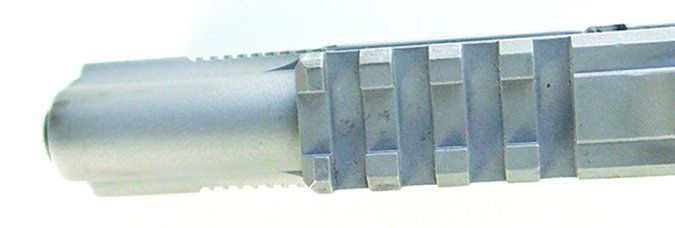
Our Team Said: The crew was split on the easy maintenance advantage of the Rail Gun and the full-length guide rod and increased rigidity of the TRP. If we were arming a battalion, the Rail Gun is the best, we feel. In contrast, the TRP feels more like a SWAT-trained officer’s firearm. The TRP’s self-luminous iron sights are also an advantage. As for absolute accuracy, the Rail Gun was more accurate than either the Loaded Model or the Combat Elite, but not as accurate as the TRP. The best effort hovered around a 1.25-inch group with the American Gunner 185-grain XTP, but the average was not as good as the TRP’s.
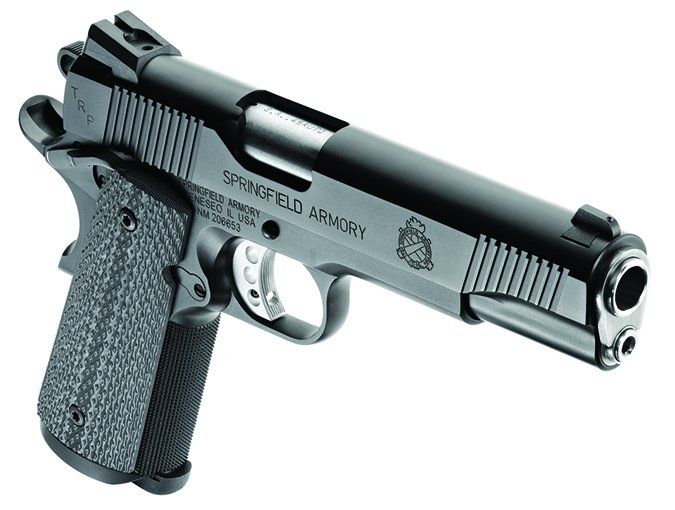
Springfield Armory TRP PC9108LP 45 ACP, $1347
GUN TESTS GRADE: A (Our PICK)
This is a first-class 1911. The Springfield offered excellent reliability, accuracy, and night sights, a big advantage. Excellent slide-to-barrel fit and frame-to-slide fitting.
| ACTION | Single-action, semi-auto, locked breech |
| OVERALL LENGTH | 8.5 in. |
| OVERALL HEIGHT | 5.7 in. |
| MAX WIDTH | 1.5 in. |
| WEIGHT UNLOADED | 42 oz. |
| WEIGHT LOADED | 45.5 oz. |
| BARREL | 5 in. match grade stainless steel, 1:16 twist; full-length guide rod |
| MAGAZINE | (2) 7-Rd. stainless steel with slam pads |
| SLIDE | Carbon steel, black armory kote |
| FRAME | Carbon steel, black armory kote |
| FRAME FRONT STRAP HEIGHT | 2.6 in. |
| FRAME BACK STRAP HEIGHT | 3.2 in. |
| GRIPS | Black & grey G10 checkered |
| GRIP THICKNESS (MAX) | 1.3 in. |
| GRIP CIRCUMFERENCE (MAX) | 5.4 in. |
| SIGHTS | Low profile combat, 3-dot tritium |
| TRIGGER PULL WEIGHT SINGLE ACTION | 5.5 lbs. |
| TRIGGER SPAN SINGLE ACTION | 2.5 in. |
| SAFETY | Slide lock, grip |
| WARRANTY | Lifetime |
| TELEPHONE | (800) 680-6866 |
| SITE | Springfield-Armory.com |
| MADE IN | Geneseo, Illinois |
The Springfield Tactical Response pistol was originally offered as an affordable version of the Professional Model. The fit and finish were noticeably superior to the Loaded Model, and to our eyes, it was on par with the much more expensive Professional Model. (Bud’s listed one for $2,345.)
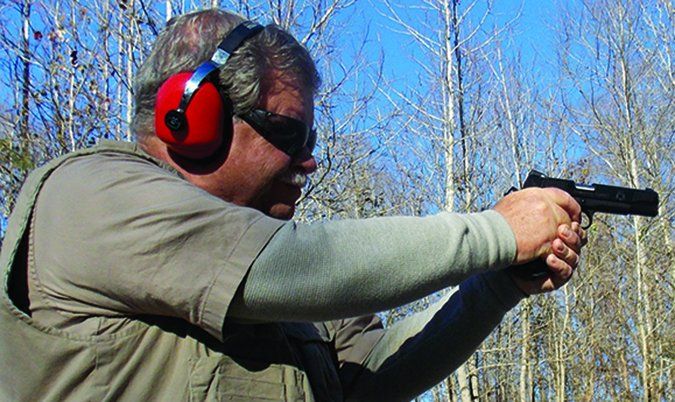
The TRP pistol we tested was supplied with two magazines, a plastic range holster, and dual magazine carrier. The TRP uses a lightweight firing pin and heavy firing pin spring as a safeguard and does not incorporate a firing pin block into the action. When racking the slide of the TRP, we believe the fit was tighter than the Colt Combat Elite or Rail Gun and much tighter than the Loaded Model. But better fit wasn’t the only edge. The Springfield racked up features to offset the $332 price differential between it and the Combat Elite, and the $148 difference between it and the Colt Rail Gun. However, at $557 above the Loaded Model, you will need a good reason to justify the price difference, and a lot of training and practice, to make use of the TRP’s superior performance. If you do not need or desire these features, they are irrelevant, but some are good to have.
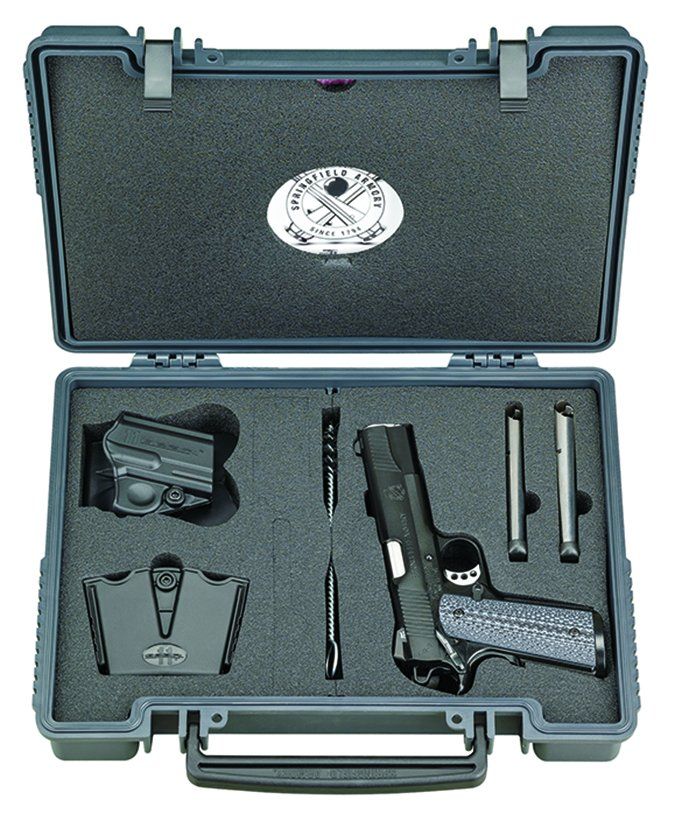
The Springfield TRP features a Teflon-based coating that proved durable during our testing and it was self lubricating. Still, we lubricated the pistol just the same as most users will. The fit of the slide to the frame was tight, with very little lateral play. The cocking serrations forward and rear are a bit longer than the Colts’. The Novak sights were identical, save the TRP featured self-luminous tritium inserts, which are a pricey and helpful upgrade. The full-length guide rod offered reasonably rapid disassembly by use of an Allen wrench compared to a two-piece guide rod that may be unscrewed by hand. We only report on what we observe, and the Springfield full-length guide rod did not loosen and was easy to field strip. The slide-lock safety was ambidextrous and gave the TRP another advantage. Fit and crispness of the slide lock safety and magazine release were each excellent. The trigger action was clean and broke at 5.5 pounds.
A big advantage was the TRP’s checkered front strap, which presented 20-lines-per-inch checkering that gave good adhesion when firing. Coupled with checkered G10 grips, most of our shooters liked how the gun felt during tactical firing. One of the female raters felt the checkering was too sharp for her palm. Our most experienced rater also found the abrasion to be a bit sharp and saw the checkering left an outline in his palm. To control the pistol in stressful times, with sweaty or wet hands, these textures are helpful. The strategy to avoid tearing your hands up during high-volume shooting is to wear gloves during the bulk of your practice. Outside the test, we should note that one of the raters used a TRP for more than a year as a daily carry gun and eventually changed to a Novak Custom Gun, largely based on abrasion and weight of the TRP.
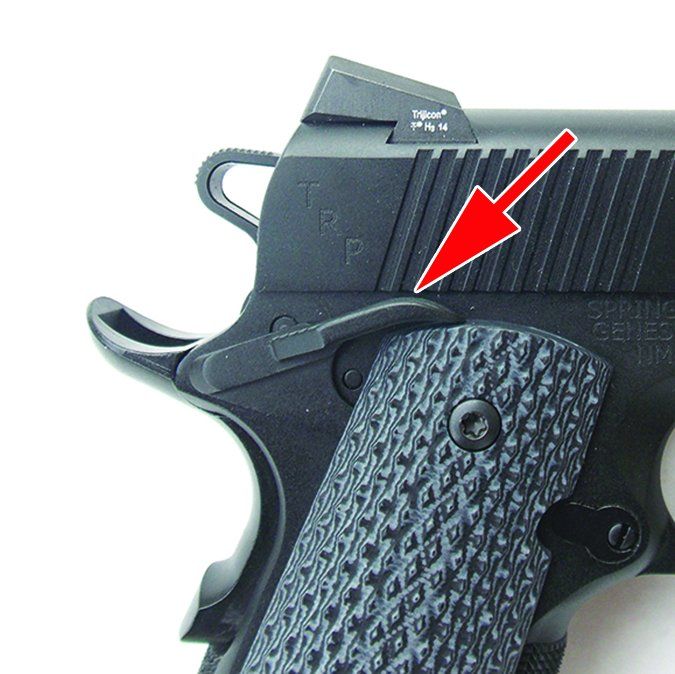
Elsewhere, the grips were made of G10 composite and were well turned out and offering good abrasion. They were slightly thicker than the Colt Combat Elite grips. The TRP also featured a magazine chute. Be aware that this chute isn’t compatible with every type of bumper pad. We used the supplied magazines and five Brownell’s 7-round magazines. We fired the Springfield on the same combat course, with the same ammunition, and fired each pistol at the same time with raters alternating with each handgun. We made several observations. The Colts and the Loaded Model were faster from leather and faster on target. The Colt Combat Elite was lighter, and perhaps the tactical grips made for better speed. The difference wasn’t great but was noted. However, once on target, the Springfield TRP’s superior checkering and abrasion made a difference. The pistol was more controllable than the Colts. To less experienced raters, there was little difference. For those grasping the TRP as tightly as possible and controlling the trigger, the TRP was the more controllable handgun in rapid fire. During combat firing the TRP showed an advantage in delivering rapid hits and controlled double taps.
Also, the Springfield TRP proved more accurate than the other pistols. The single best group was a 1.25-inch group with the Winchester 230-grain JHP, the hottest load tested with the most energy and recoil. The heavier trigger of the TRP was not a significant factor in benchrest accuracy, we found. On a bright sunny day, the sun glinted on the night sights, which is worth noting.
Our Team Said: If you do not need the extra features of the TRP, and are not willing to master the gun, the difference in price may be a deal breaker. However, for that money you get tritium night sights, an ambidextrous slide lock safety, front strap checkering, a magazine guide, a hard-use finish, superior combat accuracy and superior bench rest accuracy. An aftermarket Teflon finish alone would cost nearly the price difference between the Colt Combat Elite and the Springfield. We rated the Springfield TRP the best performer in this race, and we’d pay the extra money for it if we could afford it. While not a Best Buy, it is Our Pick.
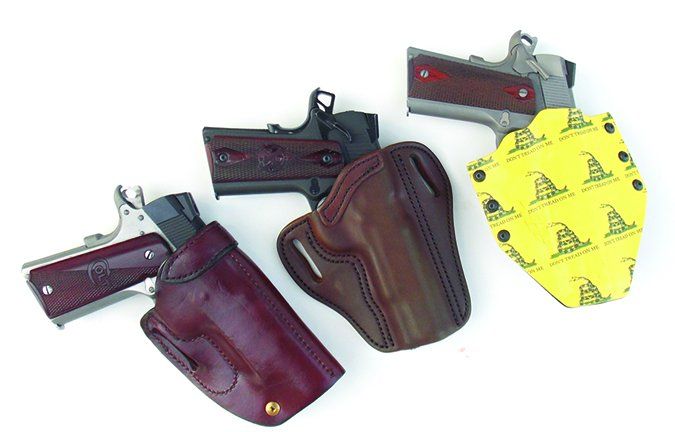
Written and photographed by R.K. Campbell, using evaluations from Gun Tests team testers.































I’d like to see a head to head match up between the Sig Sauer TacOps 10mm and the Springfield Armory TRP 10mm in the five inch barrel. I’m looking to buy the best between those two. Been thinking of doing a magma-port on the one I purchase to help tame the recoil. I purchased an EAA Hunter Elite 10mm a few years ago with the six inch barrel and had that ported with a three hole configuration about a third of the way down the barrel as measured from the muzzle. I found the recoil tamed down to a 9mm+P+ and accuracy remained superb.
Okay, I’ve forwarded your request for development. Thanks for the idea. Todd Woodard, Editor
Achat Cialis en ligne fiable [url=https://tadalmed.com/#]cialis prix[/url] Cialis sans ordonnance 24h tadalmed.com
pharmacies en ligne certifiГ©es [url=https://pharmafst.shop/#]Livraison rapide[/url] pharmacie en ligne pas cher pharmafst.shop
Tadalafil achat en ligne [url=https://tadalmed.shop/#]cialis prix[/url] cialis generique tadalmed.com
pharmacie en ligne france fiable [url=https://pharmafst.com/#]pharmacie en ligne[/url] pharmacie en ligne france livraison belgique pharmafst.shop
Pharmacie sans ordonnance [url=http://pharmafst.com/#]Livraison rapide[/url] acheter mГ©dicament en ligne sans ordonnance pharmafst.shop
pharmacie en ligne france livraison internationale [url=https://pharmafst.shop/#]pharmacie en ligne pas cher[/url] pharmacie en ligne sans ordonnance pharmafst.shop